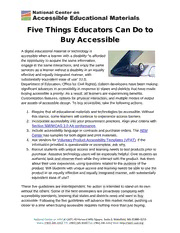
ERIC ED601686: Five Things Educators Can Do to Buy Accessible PDF
Preview ERIC ED601686: Five Things Educators Can Do to Buy Accessible
Five Things Educators Can Do to Buy Accessible A digital educational material or technology is accessible when a learner with a disability “is afforded the opportunity to acquire the same information, engage in the same interactions, and enjoy the same services as a learner without a disability in an equally effective and equally integrated manner, with substantially equivalent ease of use” (U.S. Department of Education, Office for Civil Rights). Edtech developers have been making significant advances in accessibility in response to states and districts that have made buying accessible a priority. As a result, all learners are experiencing benefits. Customization features, options for physical interaction, and multiple modes of output are assets of accessible design. To buy accessible, take the following actions. 1. Require that all educational materials and technologies be accessible. Without this stance, some learners will continue to experience access barriers. 2. Incorporate accessibility into your procurement practices. Align your criteria with Section 508/WCAG 2.0 AA conformance. 3. Include accessibility language in contracts and purchase orders. The AEM Center has samples for both digital and print materials. 4. Ask vendors for Voluntary Product Accessibility Templates (VPAT). If the information provided is questionable or incomplete, ask why. 5. Recruit students with unique access and learning needs to test products prior to purchase. Assistive technology users will be especially helpful. Give students an authentic task and observe them while they interact with the product. Ask them about their user experience, using questions related to the purpose of the product. Will students with unique access and learning needs be able to use the product in an equally effective and equally integrated manner, with substantially equivalent ease of use? These five guidelines are interdependent. No action is intended to stand on its own without the others. Some of the best developers are proactively complying with accessibility standards, knowing that states and districts need and want to buy accessible. Following the five guidelines will advance this market model, pushing us closer to a time when buying accessible requires nothing more than just buying. National Center on AEM at CAST; 40 Harvard Mills Square, Suite 3; Wakefield, MA 01880-3233 Voice: (781) 245-2212 TTY: (781) 245-9320 Fax: (781) 245-5212 Web: http://aem.cast.org
